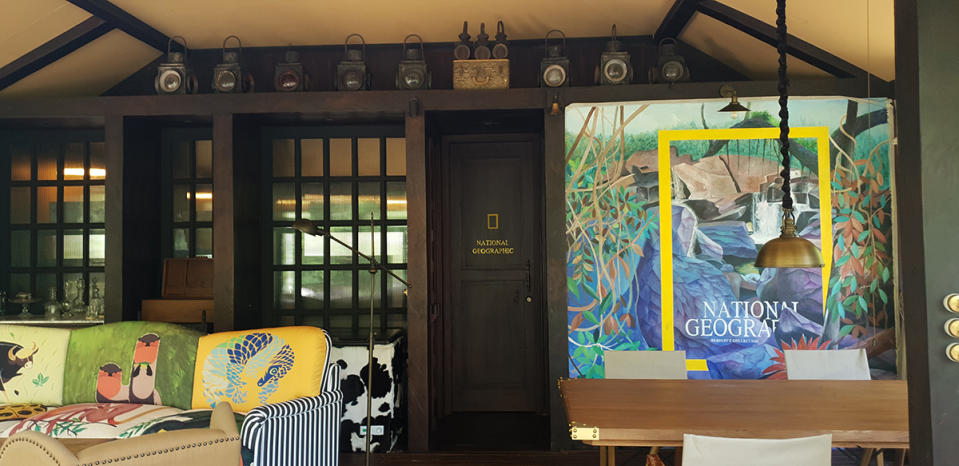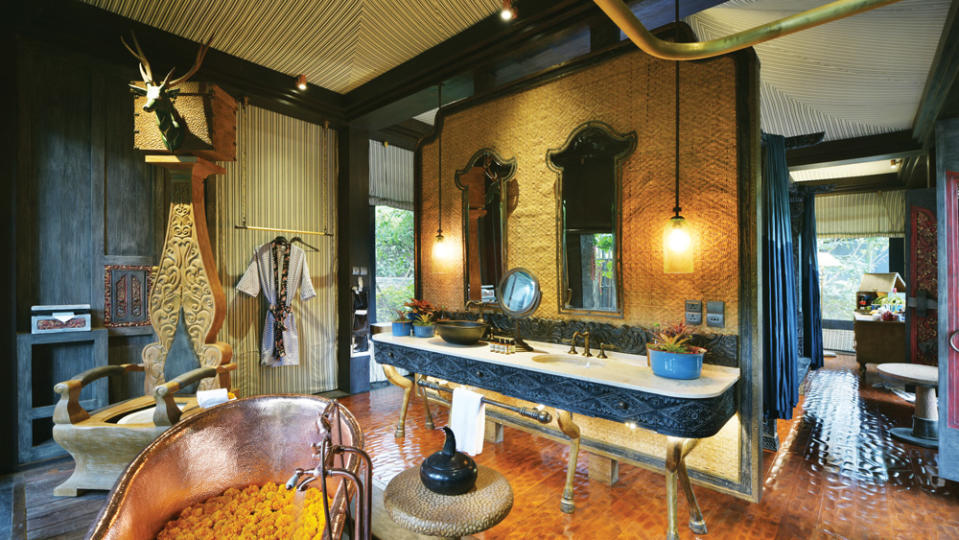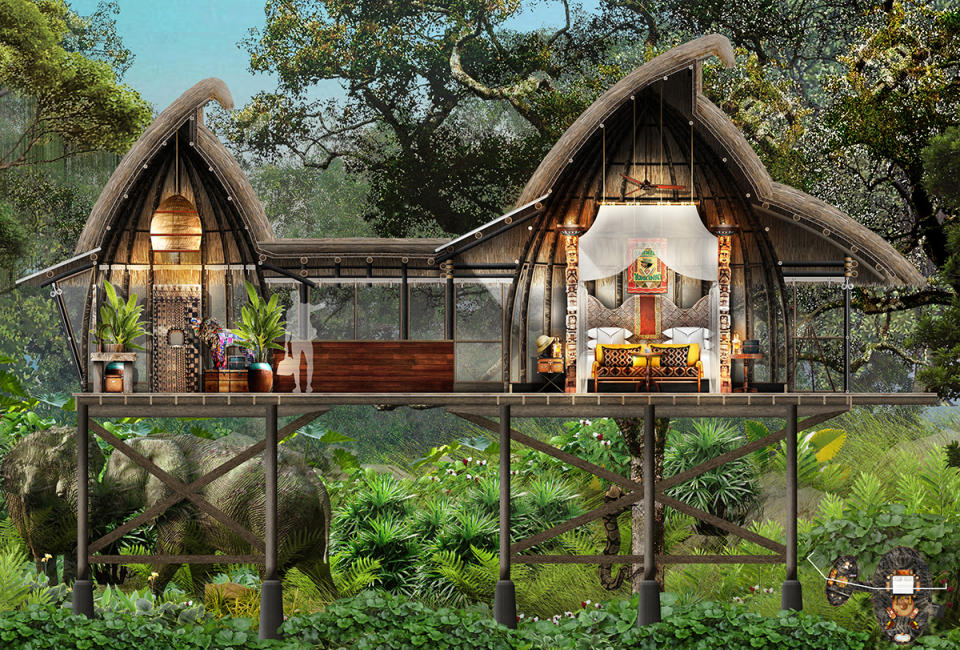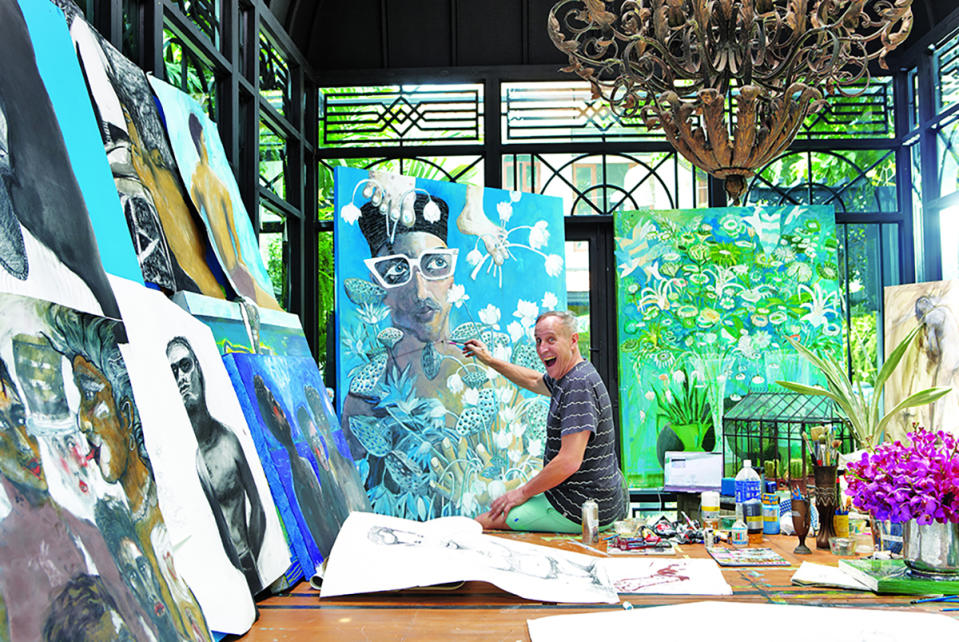Meet the Interior Designer on a Mission to Stop Luxury Hotels From Looking Bland

Architect, interior designer and hotelier Bill Bensley is sticking both his middle fingers up. His “screw you” gesture and mock-horrified grimace are targeted not at anyone in the room, but at lazy, clichéd ideas of what luxury should look like.
“I’ve been there, done that,” he says of marble floors and grandiose chandeliers. “Everybody’s seen all that stuff before.”
More from Robb Report
'The White Lotus' Is Already Boosting Tourism in Thailand Ahead of Season 3
Walton Goggins Says 'The White Lotus' Season 3 Scripts 'Blew His F**King Mind'
Who Needs Crowds? Why Off-Season Travel Is the Smartest Way to Vacation
Speaking from the new home he designed for himself, his partner and their five Jack Russells in northern Thailand’s Chiang Mai, he’s wearing a plain red T-shirt that’s spattered with paint. The sides of his head are shaved. At 65, he’s youthful, exuberant—still in full possession of the energy necessary to lead a one man war against the “blandification” of luxury. His clarity of vision has helped to establish him as one of the world’s only brand names in hotel design.
“If you design a hotel for everybody, you design it for nobody,” says Bensley, who is behind a fresh crop of new hotels opening over the next two years. “Unfortunately, ‘off-white’ is 90 percent of the sales in interiors. It’s a shame. People are missing out.”
Born in Orange County, Calif., he attended the State Polytechnic University’s Landscape Architecture, and later Harvard’s Graduate School of Design. Since 1989, his eponymous studio BENSLEY, with offices in Bangkok and Bali, has taken on more than 200 projects. Many of those hotels, resorts, spas, homes, bars and palaces are the best in Asia. Bentley was tapped for the Four Seasons Tented Camp Golden Triangle in Thailand, the Capella Ubud in Bali and Rosewood Luang Prabang, Laos. He’s behind the Royal Istana Palace in Malaysia. Last year, his Shinta Mani Mustang project opened in remote northern Nepal as part of the Bensley Collection—which includes his passion project, Shinta Mani Wild in Cambodia’s Cardamom Mountains (a hotel he co-owns with business partner Sokoun Chanpreda).

While his maximalist, vintage, often quirky, designs at those destinations—imagine Suessian sculptures made of brass horns, throne like toilets in leather, Edwardian whimsy—withstand any accusation of blandness, his work is often compared to the stylized sets of a Wes Anderson movie. It’s a compliment he’s happy to take as shorthand for beauty, color, and attention to detail.
“Any relationship to Wes Anderson is a huge compliment,’ he says. “I’m such a big fan of his. His last movie, I didn’t understand a word of it, but it was mesmerizing to me.”
Still, Bensley wants to deny any definable signature. “Every single client who comes to me wants to have something that’s better than the hotel we opened three months ago. Everybody does. So if you stick to the same style, you also stick to the same details and style of work. That doesn’t do anybody any good. It’s a good thing not to have a particular style,” he says.
So perhaps more than the designs themselves, Bensley’s real talent is his ability to convince clients—who are often corporate investors that think with their wallets—to take design risks. Even he admits that sometimes it’s impossible.
“We did a JW Marriott in Jeju, a tiny island in South Korea, which we opened last year, and the client wanted us to do something that was very ‘Aman,’ which, to me, is the blandest of everything,” he cackles, making the sign of a crucifix with his fingers and play-acting horrified screams like he’s being attacked by vampires. “I did it to the best of my ability. If anyone says anything we’ve done is ‘bland,’ it will be that…I get along with most people, but there is always somebody who thinks they know better and you really wonder, ‘Well, why the f—k did you hire me for?’”

Luxury hotels make other mistakes that Bensley finds even more offensive than unoriginality. “I just came back from India, I’m doing a lot of work there. Everywhere—everywhere— you see those tiny little plastic bottles. You walk in the front door of the Taj hotel and they serve you a tray of little plastic bottles. That is immediately a total turn-off for me. Give me something in a glass.”
For him, not only does the luxury hospitality mentality lack literal color, there is also a “grayness” of imagination. He laughs when I mention the sudden rise several years ago of hotel staff telling new arrivals “Welcome home” (which lacks sincerity when you hear it everywhere) or placing their hand over their heart when interacting with guests (unnecessary, odd, embarrassing for all concerned).
“This is something at Shinta Mani we absolutely tell our guys not to do,” he says. “We tell them not to say ‘How was your flight?’—all those meaningless questions. If someone asks a question, it should be something they’re really interested in.”

The trend Bensley is glad to see catching on is that travelers are much more conscious of how they spend their money, “much more than 10 years ago,” he says. “They’re concerned about who is paying back in the community, who is treating their people right, who is doing conservation and doing the right thing in the world.”
That’s so important because, no matter how exotic the design, you cannot impress wealthy guests with design alone. After all, their homes in many cases out do the 5-star hotels they stay in.
“The experiences we create have very little to do with decoration,” says Bensley. “What I strive for is to teach people something in each particular place. If someone can come away and they’ve learned something new, they’re going to remember your hotel. It’s learning about conservation or how poor a lot of South-east Asia is. People might come from nicer places than the hotels we’ve built but they’re not going to learn the same things.”

He’s currently excited about Kozala Zamba, a new project he’s working on with the Congo Conservation Company in the Congo, expected in 2026. It consists of four tiny camps, spanning Nouabalé-Ndoki National Park and Odzala-Kokoua National Park, which will help provide greater protection against illegal logging and poaching.
“The last time I was there, it took a 42-kilometer march through water up to our knees to get there,” he says. “But by doing that, you really understand how the jungle works. I’m marching with the Ba’Aka, the Pygmies, spending time with them, understanding what building materials they use, how they build their houses, how they respect their jungles. That absorbs very deeply into me.”
In Udaipur, where he’s working on the new Ritz Reserve on a lake Pichola Lake (December 2025), he researched the local stone, textiles, glass and plaster work, which he calls “probably better than anywhere else in the world.” In Luang Prabang, where he is currently renovating his Bensley Collection property, he spent a week making drawings of his favorite columns, pedestals and steeples in the region. He plans to reopen the resort as a new Shinta Mani at the end of 2025. The next Shinta Mani will then be in Kathmandu.
“I’m like a kid in a candy shop, I want to eat everything,” he says. He wants to give it all back, too. For almost 20 years, he’s been helping 22 villages to the north of Siem Reap in Cambodia via the Shinta Mani Foundation, which aids work in education, skills training, microfinancing, water and healthcare, as well as wildlife conservation.
“DDT has been reintroduced into the farms,” he says. “We’re seeing cerebral cancer in five and six year old kids. It’s horrible what’s happening there. In my final years, my big goal is to help people like that as much as we possibly can. This year, I’ll probably end up building 60 to 80 homes for these guys. I’ve started a formula program for babies. Many young mums in Cambodia have to go back into the fields to tend the rice, so they’ll stop breastfeeding, and their babies are on rice and water from three months old, so many of the kids are stunted and not getting proper nutrition. We’ve got great donors, like the Walton and Bezos families. I had lunch last week with Bill Gates; he’s a fantastic guy and he made a donation. We’re using all of that money very wisely.”
He also donates from his “featured designer” roles for Baker-McGuire furniture and with Jim Thompson Fabric. He operates “Painting With A Purpose,” which has raised $250,000 from auctions at Four Seasons Bangkok and W Hotel Bangkok. The money goes to his foundation and Wildlife Alliance, the NGO whose armed rangers protect the 865-acre forest and wildlife around Shinta Mani Wild.
So is making a difference to people’s lives and healing the environment more satisfying than building a new hotel? “Yes,” he grins, mouthing the words silently, like he doesn’t want the hotel owners who pay him big bucks to design their properties to hear where his real priorities lie. “Way, way more satisfying.”

So could it be that the three-pronged Bensley attack—out-of-the-box design, cultural erudition and philanthropy—is the formula to reanimating the corpse of luxury we’ve been waiting for? Perhaps. In 2020, he published a Sensible Sustainability Solutions white paper for the global industry, pushing for hotels to have a purpose beyond just selling rooms.
“I said ‘luxury is dead,’” Bensley recalls. “But really what I meant is ‘Let’s dig deeper.’”
Best of Robb Report
The Ultimate Miami Spa Guide: 15 Luxurious Places to Treat Yourself
The 7 Most Insanely Luxurious Spas in the World, From Tokyo to Iceland
17 Reasons the Caribbean Should Be at the Top of Your Travel Itinerary
Sign up for Robb Report's Newsletter. For the latest news, follow us on Facebook, Twitter, and Instagram.


